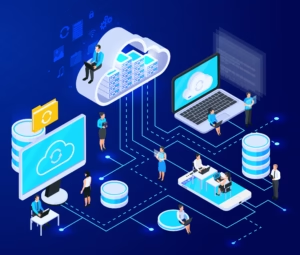In 2025, Key cloud computing trends

Cloud computing has evolved at a rapid pace over the past decade, and its growth shows no signs of slowing down. As we approach 2025, businesses and technology professionals are keeping an eye on the latest trends in the cloud space to stay ahead of the curve. From artificial intelligence integration to enhanced security measures, cloud computing will continue to shape the future of IT and business operations in profound ways.
AI and Machine Learning Integration
Artificial intelligence (AI) and machine learning (ML) have already made significant inroads into the cloud, and by 2025, their integration will be even more seamless and widespread. Cloud service providers like AWS, Azure, and Google Cloud are increasingly offering AI and ML tools as part of their standard offerings, making these technologies accessible to businesses of all sizes.
With these tools, organizations will be able to automate processes, gain deeper insights into their data, and make more informed decisions—all without having to build complex infrastructure. Cloud-based AI solutions can help businesses optimize everything from customer service (via chatbots) to predictive analytics and supply chain management.
The rise of AI-powered cloud services will enable companies to drive innovation without requiring extensive in-house expertise. In 2025, we can expect AI and ML to be integral components of the cloud, allowing businesses to scale their operations and create personalized experiences for customers with ease.
Serverless Computing Growth
Serverless computing is one of the most exciting developments in cloud technology, and it’s expected to grow exponentially in 2025. With serverless computing, developers no longer need to manage the underlying infrastructure of their applications. Instead, they can focus solely on writing and deploying code while the cloud provider automatically handles scaling, server management, and cost optimization.
This model allows businesses to run applications without worrying about infrastructure, reducing operational overhead and accelerating development timelines. Serverless computing also offers significant cost savings since organizations only pay for the computing resources they use rather than provisioning fixed resources upfront.
By 2025, more businesses will adopt serverless architectures to build and deploy cloud-native applications, streamline their operations, and create more agile environments. As serverless technologies evolve, developers will be able to leverage a broader set of tools and frameworks to accelerate innovation.
Edge Computing Expansion
Edge computing, where data is processed closer to its source (such as IoT devices or sensors), will be one of the defining trends of 2025. As more devices become connected to the internet and generate massive amounts of data, organizations will need to process that data quickly and locally to avoid latency issues. This is especially crucial for industries such as healthcare, manufacturing, and autonomous vehicles, where real-time data processing is essential.
In traditional cloud models, data is sent to a centralized data center for processing, which can introduce latency and bandwidth challenges. With edge computing, data is processed on the “edge” of the network, closer to where it is generated, allowing for faster insights and more responsive systems.
By 2025, we expect cloud providers to significantly expand their edge computing infrastructure, enabling businesses to deploy solutions that rely on real-time data processing. As a result, we’ll see innovations in industries like smart cities, healthcare, and logistics, where the ability to process data locally will be a game-changer.
Multi-Cloud and Hybrid Cloud Strategies
By 2025, multi-cloud and hybrid cloud strategies will become the norm for many businesses, enabling them to leverage multiple cloud platforms to optimize their operations. A hybrid cloud combines private cloud infrastructure with public cloud services, allowing companies to maintain control over sensitive data while still benefiting from the scalability and flexibility of the public cloud. Multi-cloud strategies involve using multiple cloud providers to avoid vendor lock-in and choose the best solutions for specific business needs.
The shift to multi-cloud and hybrid cloud architectures provides businesses with greater flexibility, enhanced reliability, and more control over their data. It also allows organizations to avoid dependence on a single cloud provider, which can be risky if that provider experiences outages or performance issues.
In 2025, organizations will increasingly rely on hybrid and multi-cloud environments to drive digital transformation, ensuring they can leverage the best cloud services available while maintaining control over their most critical workloads.
Cloud Security and Privacy Innovations
With data breaches and cyberattacks on the rise, cloud security will be a top priority for organizations in 2025. As businesses move more of their operations to the cloud, they need to ensure that their data is secure, protected, and compliant with increasingly stringent regulations like GDPR and CCPA.
Cloud providers are stepping up their efforts to enhance security by implementing cutting-edge encryption techniques, identity management tools, and AI-powered threat detection systems. In addition, the growing adoption of zero-trust security models, where every user and device is continuously authenticated, will become more widespread in cloud environments.
In 2025, expect cloud providers to offer even more robust security features to protect against the evolving landscape of cyber threats. Organizations will need to carefully assess their cloud security strategies to stay ahead of potential risks and ensure that their data remains safe and compliant.
Conclusion
As we move into 2025, cloud computing will continue to drive digital transformation across industries, offering businesses new opportunities to innovate and optimize their operations. The trends discussed in this blog—AI and ML integration, serverless computing, edge computing, multi-cloud and hybrid cloud strategies, and cloud security innovations—will shape the cloud landscape in profound ways.
Organizations that stay on top of these trends and adapt their strategies accordingly will be well-positioned to thrive in the cloud-driven future. Whether you’re looking to harness the power of AI, streamline your infrastructure, or bolster your security posture, the cloud will be a critical enabler of growth and success in the years to come.
